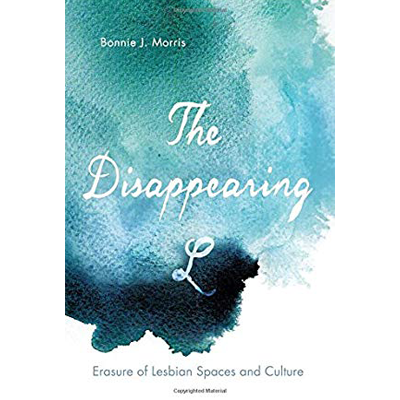
The Disappearing L: Erasure of Lesbian Spaces and Culture by Bonnie J. Morris
Maybe it's not surprising that any civil rights movement changes its terminology over time. In a few decades, we've gone from 'homosexual' to 'gay' to 'lesbian and gay' to the all-inclusive LGBTQIA. However, with greater visibility for other identities, women who love women face another round of oversight and invisibility. In "The Disappearing L," Bonnie J. Morris reclaims the history and accomplishments of lesbian feminist culture.
Full disclosure: I came out during the years described by "The Disappearing L," and I'm very close to the world Morris describes. It's odd, but I suppose necessary, to read about the music I heard at concerts and in my own apartment on vinyl LP; to read quotes from lesbian writers I idolized and tried to imitate; to relive women-only music festivals I attended for years. It's all documented here as a period like the Renaissance or The Sixties, written for posterity.
Lesbian feminists were mocked by both straight and gay men as humorless, 'politically-correct' folk-music festival-goers. Morris explodes this stereotype, naming a wide variety of artists recording and performing rock, punk, soul, blues, Latin and classical music at festivals all over the U.S. Women's festivals were well-organized tent cities complete with utilities, food, daycare, handicapped accessibility, health care tents and transportation. I wish Morris included more about the hilarious lesbian comedy at festivals, concert venues and bars, if only to combat the stereotype of the humorless lesbian feminist. At performances by Kate Clinton, Lea DeLaria, Marga Gomez, Karen Williams and others, I can remember laughing until I couldn't catch my breath.
Morris compares women's music festivals to Jewish orthodox communities with interesting results; I thought this chapter could be an entire thesis. She also examines women's studies programs in academia, which were first attacked as being run by lesbians, then renamed 'gender studies,' weakening the emphasis on women. Around this time, literary criticism began to use a 'confusing ‘insider' language' that 'alienated … those who, while well-versed in local community building and grassroots political experience, did not speak the rarefied Ivory Tower English required for ‘serious' publication.' The irony of Morris publishing within the SUNY Series in Queer Politics and Culture, though, is relieved by her easily accessible writing.
The most poignant chapter for me was the last, 'Points of Erasure: Remembering Generation Flannel,' and I appreciate the affectionate nod to another stereotype. Morris outlines the loss of lesbian spaces and various causes: pressures from right-wing attacks, economic concerns, burnout, and plain old sexism. But our history must not disappear. To paraphrase Adrienne Rich, the unspoken becomes the unspeakable. And as Morris says, 'For the next generations to understand what lesbians of the 1970s, ‘80s, and ‘90s contributed to a vibrant performance culture and political community, fair and equal homage must be paid, and the ‘L' positioned in today's world as owning a speakable heritage.'
